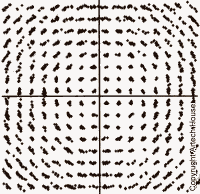Multi-Gigabit Microwave and Millimeter-Wave Wireless Communications
|
|
Click here for the complete list of RF Cafe Quizzes. Note: Some material based on books have quoted passages.
1. Which entity is the primary regulatory agency in the world with responsibility for coordinating shared global use of the radio spectrum? a) WWR (World Wide Radio) b) GCU (Global Communications Union) c) URU (Universal Radio Union) d) ITU (International Telecommunication Union)
2. What is a primary obstacle to FSO (Free Space Optics) terrestrial usage? a) Very high attenuation b) Nighttime-only operation c) Difficulty generating the light d) FM radio interference
3. Which condition causes the least amount of attenuation on electromagnetic signals? a) Moist air b) Dry air c) High wind d) Low wind
4. What is the equation for determining attenuation factor (specific attenuation) due to snow and ice? (R=snowfall rate in mm/hr, λ=wavelength in mm) a) Attenuation Factor = λ/R b) Attenuation Factor = λ/R2 c) Attenuation Factor = λ/R3 d) Attenuation Factor = [(0.00349*R1.6)/λ4] + [(0.00224*R)/λ]
5. What is the equation for determining attenuation due to foliage? (f=frequency in MHz, R=depth of foliage in m) a) Loss = 10 log (f2R) b) Loss = 20 log (fR) c) Loss = 20R log (f) d) Loss = 0.2f0.3R0.6
6. What is a primary feature of a plesiochronous digital hierarchy (PDH) system? a) Running in a state where different parts of the network are nearly, but not quite perfectly, synchronized b) Having features discovered in the Plesioic era c) Operating in an orthogonally asynchronous state d) Using a deterministic hierarchy
a) An NTSC test signal for CATV b) 256 QAM with phase noise c) The whirlpool constellation d) RF astigmatism
8. Which frequencies in the 60 GHz band are allocated by the FCC for unlicensed use? a) 57 to 64 GHz b) Only at 60 GHz c) 71 to 74 GHz d) There are no unlicensed bands at 60 GHz
9. What is a link budget? a) The cost of a communications system b) The total link count in a communications system c) A fictitious number representing system performance d) An accounting of all gains and losses in a communications system
10. Which city would likely have higher 23 GHz system availability due to weather? a) Riyadh, Saudi Arabia b) New Your City, USA c) Sydney, Australia d) Singapore, Singapore
Need some help? Click here for the answers and explanations. |


 7. What does the image to
the right depict?
7. What does the image to
the right depict?